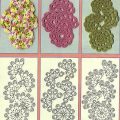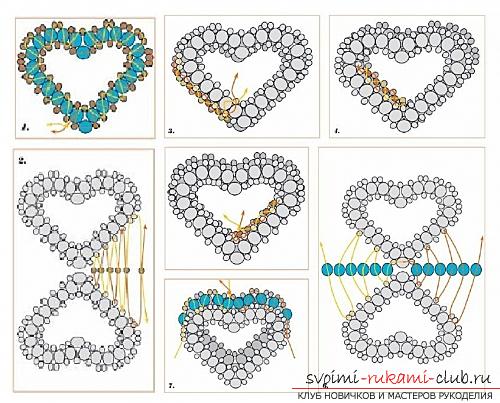
Master classes on weaving various charms and pendants with diagrams, photos and descriptions.
Ornaments have been worn since the very first people. Bark of trees, beautiful stones, pieces of bone, shells and much more served as accessories that performed decorative and ritual functions. They were made independently for protection from evil spirits and other misfortunes, and also decorations were an indicator of the status or a direction of activity. Ancient hunters, for example, wore necklaces or pendants from the claws and teeth of the animals they killed. Humanity developed, there were different options and types of jewelry. At the same time, they still served as a status indicator. Products made of precious metals and stones - for wealthy people. The story of one of them - the key fob started around the 18th century. It was then that it was separated from the pendants, as an independent decoration. The keyring, unlike the pendant, was more of a masculine version of the decoration, and wearing it was a whole art. He fastened to bracelets or chains of watches. Proper treatment of him was an indicator of refinement, good taste and social status of the owner. Charms and trinkets are popular until now. Now the last - a bag of unisex. It is worn by both men and women, while, in the main, they are used as utilitarian necessity, fastened to a ring of keys. Even in this role, the key chain can serve as a decoration. Having created an original and beautiful key chain with your own hands, you can turn it into an elegant accessory or a memorable and cute souvenir. In this article, several master classes on weaving of pendants and charms from beads will be offered. The first master class is devoted to creating a keychain "soccer ball". It will be a wonderful gift for any football fan. 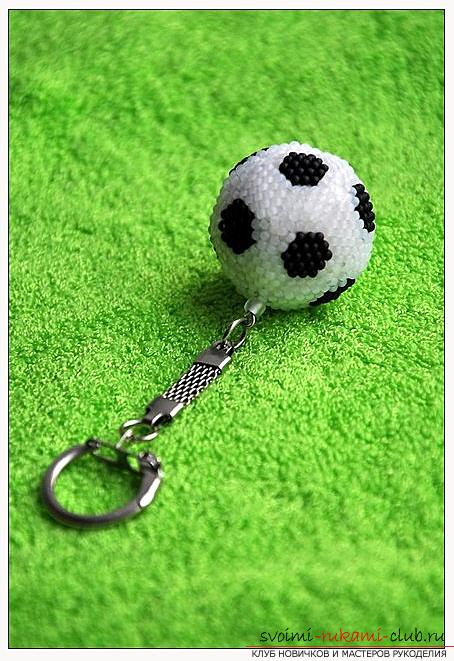 I use the Ndebele method and the mosaicweaving. First it is necessary to make separate details, calculating where should be a piece of a dark hexagon. To do this, weave a certain number of triangles, sew, and then create the rest, attaching them along the way. It will take:
I use the Ndebele method and the mosaicweaving. First it is necessary to make separate details, calculating where should be a piece of a dark hexagon. To do this, weave a certain number of triangles, sew, and then create the rest, attaching them along the way. It will take:
- White and black beads:
- The line;
- Bead of large diameter;
- Mounting for the key ring with a carbine clip.
String 3 beads in a ringlet. For the second circle, stringing two beads between each bead of the first circle, you get 3 times 2 beads. The line leaves the first bead of the second circle. Dial 2 beads, pass the line through the second bead of the second circle - this is the first ray of Ndebele. String 1 bead, pass the line and again thread 2 beads. Alternate 1 and 2 beads. It turns out 3 rays ndebele. They will be the angles of the future triangle. The line must come out of the first bead of the circle. 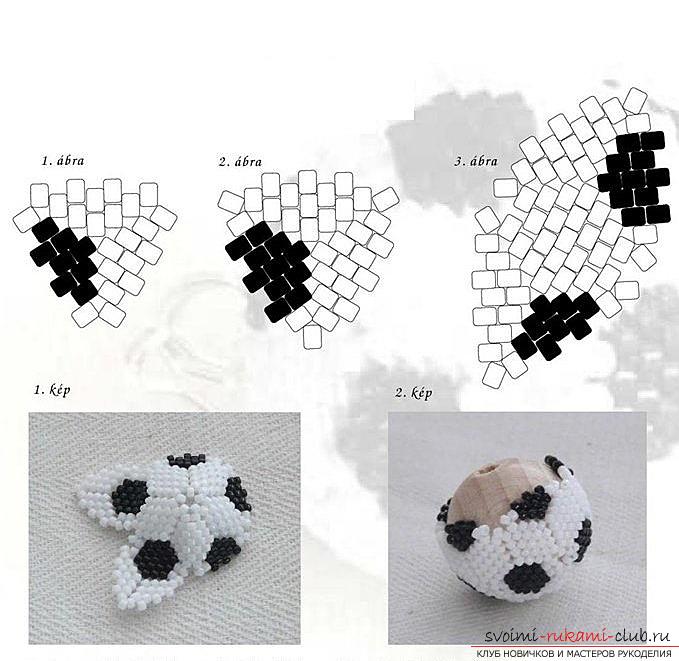 Draw on the drawing. In the Ndebele technique, corners are formed, sides - in mosaic technique. Weaving one triangle, it is better to immediately attach it to the workpiece. In this case, there will be no confusion and the soccer ball will look neat. Triangles are sewn on a mosaic method of weaving. The next beaded craft can be used as a pendant, pendant and key chain. It is woven in an ethnic style that has remained popular for a long time.
Draw on the drawing. In the Ndebele technique, corners are formed, sides - in mosaic technique. Weaving one triangle, it is better to immediately attach it to the workpiece. In this case, there will be no confusion and the soccer ball will look neat. Triangles are sewn on a mosaic method of weaving. The next beaded craft can be used as a pendant, pendant and key chain. It is woven in an ethnic style that has remained popular for a long time. 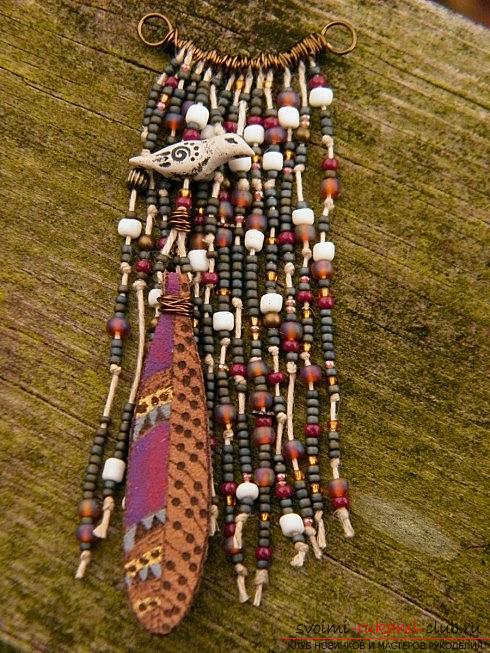 It will take:
It will take:
- Multicolored beads of different shapes and sizes;
- Wire (thicker and thinner);
- Strong rope made of flax (thin);
- Feather (natural or leather).
From a small piece of thick wire to form a workpiece with round loops around the edges. The distance between the loops is about 2.5 cm.  From linen rope to cut 7 pieces not less than10 - 11 cm. Secure all pieces on a wire with eyelets. To do this, fold it in half and pass the rope tails through the fold loop so that the wire is between the tails and the fold. To fix all rope pieces on the workpiece with the help of turns of a more delicate wire.
From linen rope to cut 7 pieces not less than10 - 11 cm. Secure all pieces on a wire with eyelets. To do this, fold it in half and pass the rope tails through the fold loop so that the wire is between the tails and the fold. To fix all rope pieces on the workpiece with the help of turns of a more delicate wire. 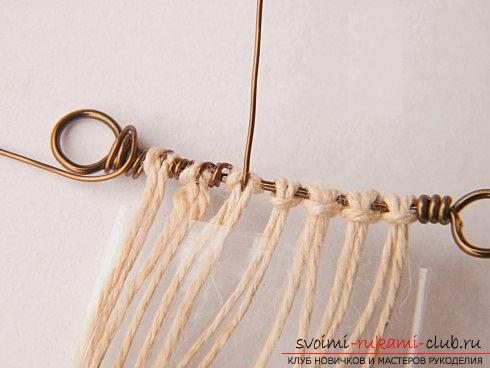 It remains the easiest, random beadsand beads on rope segments in an arbitrary and liked order. Fasten the feathers. To ensure that the beads do not slide on the tail of each thread to tie a knot.
It remains the easiest, random beadsand beads on rope segments in an arbitrary and liked order. Fasten the feathers. To ensure that the beads do not slide on the tail of each thread to tie a knot. 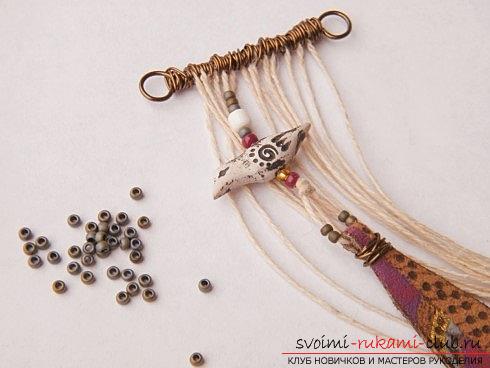 Now just put in the wire loopsribbon or lace and the suspension is ready. The next keychain with beads Baroque will be a great addition for both a capacious handbag and a small clutch. Decorate with a purse and, of course, a ring of keys.
Now just put in the wire loopsribbon or lace and the suspension is ready. The next keychain with beads Baroque will be a great addition for both a capacious handbag and a small clutch. Decorate with a purse and, of course, a ring of keys.  These beads look very rich, at the same time, even beginners in beadwork will be able to weave such intricate beauty. It will take:
These beads look very rich, at the same time, even beginners in beadwork will be able to weave such intricate beauty. It will take:
- Picasso jasper beads 2,5 cm (barrel-shaped), 4 pieces;
- Faceted glass beads of light green color 1 cm;
- Faceted beads from acrylic 6 mm with (golden metallized coating);
- Pearls are light green 1 cm and 4 mm;
- Beads 3 mm gold metallic;
- Beads of golden metallic color 10/0;
- Pin;
- Ringlets 1 cm;
- Large decorative ring;
- Lanyard for tassels;
- Thin line and monofilament (transparent).
The basis of the bead to weave on two threads monasticweaving. Use kegs of jasper and faceted glass beads. Put it in a ring. A column with a rectangular cross section was obtained. Cut the line into beads, located at different ends. To put on a fishing line a bead from metal of 3 mm and to pass a fishing line in the following faceted bead. There should be 4 such beads between the green glass at both ends (or top and bottom of the barrels). One tail of the line to be postponed. String four beads, faceted bead of gold color, pearl 1 cm, again faceted golden color and four beads. This is one working arc. Pass the line through a golden bead 3 mm on the other end. Wear the components for the second arc and pass the fishing line through a gold bead 3 mm, green glass and gold 3 mm). String the components for the next arc, pass the fishing line through the golden bead 3 mm on the opposite end, dial 4 beads, pass the fishing line through the elements of the first arch (faceted gold, 1 cm pearl, faceted gold), put on 4 beads, (gold 3 mm, green glass and gold 3 mm) beads on the end. 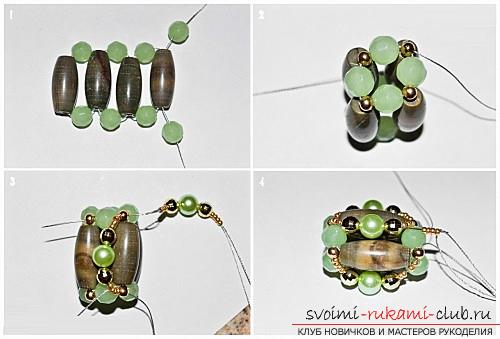 The line leaves the golden bead 3 mm. String 4 beads, 1 pearl 4 mm, again 4 beads, pass into the next gold 3 mm on the end. Weave both ends (top and bottom of the column). The line leaves the pearl 4 mm, dial 1 metallic. Bead 3 mm and pass the line to the next pearl. Make such a tightening at both ends. Pass both threads so that they come out to meet each other in a pearl 1 cm. On each ponytail wear metal. bead 3 mm and 4 beads, put on both ponytails pearl 4 mm, then on both ponytails separately put on 4 beads and 1 metal. bead. Again pass the tails to the pearl 1 cm cross each other. This is how the middle part of the Baroque is formed. Pass the fishing line through 4 bead bows alongside the 3 mm gold bead, dial 3 beads, pass the fishing line through the 4 beads of the next bow. Pass this way in a circle. Zigzags are obtained, which mask the edges of the bead bell.
The line leaves the golden bead 3 mm. String 4 beads, 1 pearl 4 mm, again 4 beads, pass into the next gold 3 mm on the end. Weave both ends (top and bottom of the column). The line leaves the pearl 4 mm, dial 1 metallic. Bead 3 mm and pass the line to the next pearl. Make such a tightening at both ends. Pass both threads so that they come out to meet each other in a pearl 1 cm. On each ponytail wear metal. bead 3 mm and 4 beads, put on both ponytails pearl 4 mm, then on both ponytails separately put on 4 beads and 1 metal. bead. Again pass the tails to the pearl 1 cm cross each other. This is how the middle part of the Baroque is formed. Pass the fishing line through 4 bead bows alongside the 3 mm gold bead, dial 3 beads, pass the fishing line through the 4 beads of the next bow. Pass this way in a circle. Zigzags are obtained, which mask the edges of the bead bell.  Lace the right color to cut into pieces. Fasten the decorative ring with two connecting rings and thread the laces in them. Fold in half and fix monofilament. String 3 metallic. beads 3 mm, put into a ring. String 2 beads, 1 pearl 1 cm, 2 beads and pass the line in the fourth bead of the first circle. So to the end. There should be 3 pearls in the circle. Next circle. Between the pearls thread on 1 gold faceted bead 6 mm. The line leaves the pearl. Dial 2 beads, 1 metal. Bead, 2 more beads and again pass the line through the next pearl. The line comes out of metal. beads, dial 2 of the same and pass the line to the next metal. bead. Pass the line through all the metal beads and slightly pull off.
Lace the right color to cut into pieces. Fasten the decorative ring with two connecting rings and thread the laces in them. Fold in half and fix monofilament. String 3 metallic. beads 3 mm, put into a ring. String 2 beads, 1 pearl 1 cm, 2 beads and pass the line in the fourth bead of the first circle. So to the end. There should be 3 pearls in the circle. Next circle. Between the pearls thread on 1 gold faceted bead 6 mm. The line leaves the pearl. Dial 2 beads, 1 metal. Bead, 2 more beads and again pass the line through the next pearl. The line comes out of metal. beads, dial 2 of the same and pass the line to the next metal. bead. Pass the line through all the metal beads and slightly pull off. 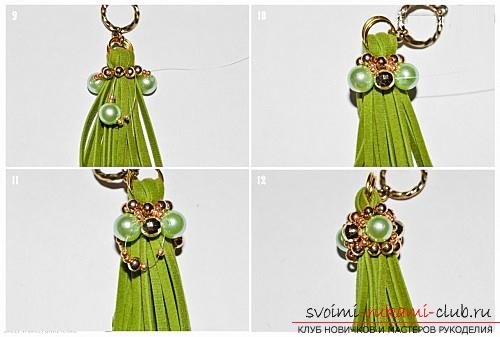 Secure the bead and string with a pin or a jewelry pin. Just pierce the bead and bend the sharp part with a ring, pre-attaching the connecting and decorative rings.
Secure the bead and string with a pin or a jewelry pin. Just pierce the bead and bend the sharp part with a ring, pre-attaching the connecting and decorative rings. 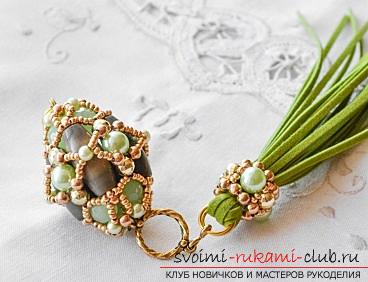 A pretty heart made of beads and beads can easily be used as a keyring, pendant or original valentine.
A pretty heart made of beads and beads can easily be used as a keyring, pendant or original valentine. 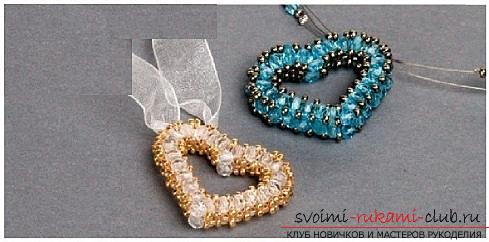 It will take:
It will take:
- Beads 10/0;
- Faceted oblong beads (length 4 mm);
- The line.
The work is carried out by monastic weaving on twothreads. String 1 bead, 1 bead, 1 more bead. Place them in the center and cross the tails in the next bead. For the next cross on each ponytail, thread 1 bead and cross the tails in the next bead. Weave only 4 crosses, the fifth weave, strung one bead on one ponytail, and on the second 2 beads, cross the tails in a bead. For the sixth and seventh crosses, repeat the previous two steps, but place two beads string on 3. The eighth and ninth crosses weave on 1 tail 1 bead on the second by 2 (on the same side as the previous magnifications). 10th cross on one bead on the tail. 11th cross to weave so on the side where there were increments strung 1 bead on the other (it turns internal) 1 bead, 1 bead and again it is a bead. Cross the tails, as usual in a bead. 12th cross on both ponytails on 1 bead (like the tenth cross). Then weave symmetrically the second half of the heart. Weave another such heart.  Following the scheme, connect the two halves of the heart toexternal and internal perimeter. In order for the keychain to look more voluminous, a series of beads of a larger size can be weaved between its halves.
Following the scheme, connect the two halves of the heart toexternal and internal perimeter. In order for the keychain to look more voluminous, a series of beads of a larger size can be weaved between its halves.




